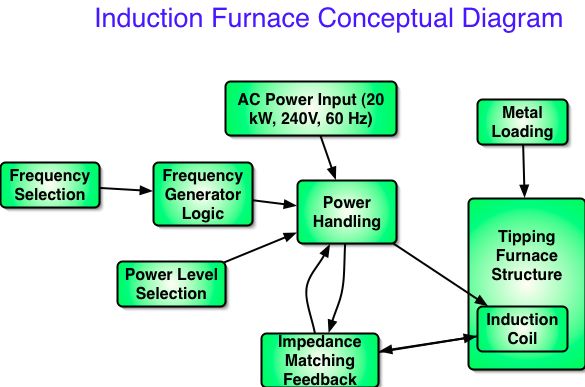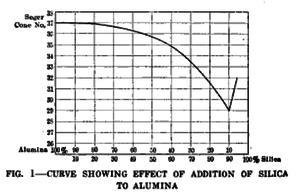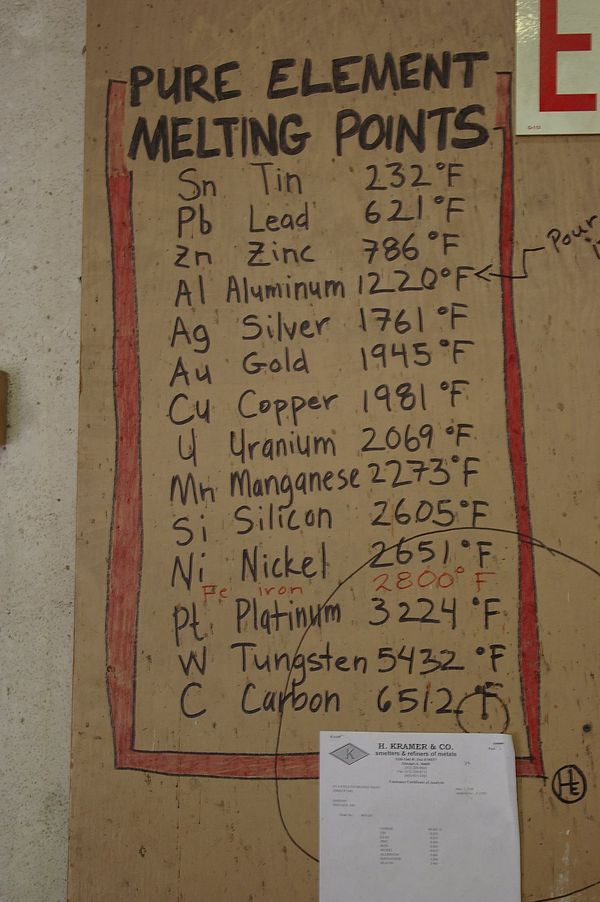Induction Furnace Overview
Main > Digital Fabrication > RepLab Tools > Induction furnace
Overview
Introduction
The Open Source Induction Furnace Project seems to be the most promising way to implement the foundry. This project involves the design of:
- a high-power induction furnace circuit (between 20 and 50 kW), and
- the melting chamber proper
test
Well, we could buy a turnkey system perhaps for $5k total used, and run it from the LifeTrac generator. The only disadvantage to this route is that if it breaks we’re dead-in-the-water – either with the impossibility of fixing closed-source technology, or a high repair bill. A single component which blows and is inaccessible for fixing could in principle turn a working power supply into worthless junk. Thus, it is worthwhile to tame this technology by open-sourcing the design.
Goals
To fulfill our foundry goals, The furnace should have the following characteristics:
- Induction furnace or any other technology that can do this within a budget of 40 kW of electric input, with minimal pollution
- Suitable for melting all metals and alloying
- 150 lb per hour steel melting furnace for casting
- 240 v ac, 40 kW power source available
(This spec implies ~260watt-hr/lb, which may be optimistic -- see Melt calculations)
Conceptual Diagram
This is a conceptual diagram of the entire Induction Furnace system from the Global Village Construction Set. The furnace is powered by 20 kW of 240VAC electricity from the LifeTrac generator. The entire system includes the power electronics, induction coil, and heating vessel - into which metal for melting is inserted. This diagram intends to document the relationship of functional components in the induction furnace system, as a basis for technical development of components and their integration.
The electronics part should be adaptable to different metals and different metal melting coil geometries. Melting coils should also be modular, such that the power electronics can feed different coils. Basic functions include selection of heating frequencies, which are required for melting different metals or metal geometries. There should be a feedback in the electronics, where the amount of power given to the coil should match the quantity/geometry of metal being melted.
Details
The complete design should include all of the following:
Induction Furnace Circuit
- Scalable from 20 up to 50 kW (perhaps even more)in units of 1 or 5 kW
- Allows for power and frequency range selection for different materials and heating devices
- small crucibles ~50kW, ~1kHz
- heat treating small parts ~5kW, ~100kHz
- Incorporates self-tuning to track the coil resonance dynamically during operation
- Power source may be either 1 or 3 phase electrical power
See also Power Supply Notes below.
Heat Dissipation System
Specifications of a cooling or heat dissipation system.
Coil
- Modular, adaptable design specifications for primary coil windings
Water-cooled copper tubing coil. Compute skin depth at operating frequency in order to estimate useful thickness of copper section.
Yoke
In lower frequency furnaces, a laminated iron yoke surrounds the coil, forming part of the magnetic circuit, increasing coil power factor, and thus improving efficiency. The yoke also mechanically resists the large radial forces from the coil. See the useful description of the art in US Pat. 5247539
Steel laminations begin to have high losses at the 1kHz frequency level and soft magnetic composites (e.g. iron powder Somaloy) might be considered. The biggest problem seems to be that the powder needs to be compressed at 20-50 tons/sq in in order to get good magnetic properties. A bit much for the CEB! Also poweder cost is unknown.
I also looked briefly at steel wire for the yoke but this paper was not encouraging.
Resonating Capacitors
Modular capacitor bank to accommodate different coil inductances and operating frequencies in different applications.
Induction heating capacitors carry high currents and larger sizes are usually water-cooled to deal with their internal heating. Typically polypropylene is the primary dielectric (due to its low loss factor), combined with dielectric oil and sometimes an additional kraft paper layer. Commercial suppliers of capacitors: [Celem] [GE]
If these high-power capacitors are to be made of local materials, the DIY Tesla coil community (e.g. [1], [2]) may have useful experience. For oil-filled-paper designs, castor oil has a long history in HV pulse applications and canola[3] oil has become commercially accepted for power frequency applications. (Canola oil is also a likely candidate for hydraulic fluid.) Oil/paper may have dielectric loss factor ~1% (as opposed to polypropylene ~0.05%) so internal heating is a major concern and effective cooling is important. Thermal runaway is possible as loss factor increases with dielectric temperature.
Melt Chamber
- Geometical design of melt chamber and basic power transfer calculations
- Should include provisions for loading and pouring
- Given our goals, which is best: a coreless or a channel induction furnace type [4] ?
- channel: useful in the melting of lower melt temperature metals; less turbulence at the surface.
- coreless: stronger stirring, simpler crucible construction, most commonly used for induction scrap melting
- Pouring: manual pouring methods are more suited to low volume production lines.
Crucible
The crucible is made of refractory ceramic which resists the high temperatures of the melt. Even the best materials erode in use, and crucibles must be replaced on a regular basis. An induction furnace crucible may be either
- separately manufactured, fired in a kiln, and subsequently installed in the furnace, or
- formed in place, and sintered (fired) in the induction furnace itself
Materials
According to this Foseco refractories brochure[5], File:Furnace-linings-ferrous-01.pdf steel foundry induction-furnace applications typically use alumina or magnesia refractories, while cast-iron foundries use high purity silica. This is related to acid/base chemistry of the melt.
Fireclay (which can be a natural alumina/silica clay) for making refractory crucibles must withstand the superheated molten steel temperature of >3000F. Fireclay [6] is temperature-rated by Pyrometric Cone Equivalent (PCE) [7]; "High Duty" (>= PCE32) or "Super Duty" (>= PCE35) is needed for ferrous metals. Such fireclay has high alumina content. (See also Aluminum Extractor feedstock.)
Some worthwhile DIY fireclay/firebrick information here
Separately made crucible
- DIY small crucible video [8]
Sintered-in-place crucible
The materials described in the Foseco brocure cited above are "dry-vibratable", meaning they are powders, rammed into place in situ, and sintered in the furnace itself, rather than being seperately made, kiln-fired crucibles. The refractory is rammed against a hollow steel internal former which defines the inside surface of the crucible. During the first power application, the former transfers sintering heat to the refractory, then either
- is melted away with the first heat leaving a fully-sintered lining[9], or
- gets removed at a lower temperature, allowing re-use[10], with final sintering completed by gas flame before the first melting run
Other Considerations
- Complete bill of materials
- Fabrication files for circuit and other components
- Sourcing information for components
- System design and process flow drawings
Notes
Benny
I just read that you plan to build up an induction furnace. That´s a an interesting and exciting plan.While reading the article some remarks came to my mind.
But before I want to introduce myself:
I am Benny from Germany, Hannover. I am diploma engineer for electrotechnology and working at the university. I am dealing with some induction heating/ melting applications like induction melting of glasses (that is possible!) and induction furnaces for cast iron.
Some remarks from my point of view:
- It is possible to build up a low cost furnace with the mentioned parameters.
- The frequency of 9,6 kHz is much to high. The efficiancy will be so bad, that it will be hardly possible to melt steel or iron. Due to the small penetration depth of about 2 mm with this frequency and this electrical resistance. So it needs a really small diameter of the crucible, and thats not helpful. Also the refractory material will be strained too much, so that a small lifetime is given. This will raise the cost for the operating.
- 50 Hz or 60 Hz is a better solution. And you can save the cost for the hf-converter.
- How much material do you want to cast at one time? The maximum, what i expect to be possible with 50 kW will be about 50 to 60 kg.
- What kind of raw material should be charged? It is important for the starting, because the initial density should not be too small (packing density). And the other question is, what kind of scrap it will be.
There are so many problems known with content of zinc (hot zinc dipped) and other materials. The lifetime of common refractory material is really small. And what is more important the security for the personal is not given without a strong exhaust system, due to the toxic steam. I expect this as a strong cost factor.
Power Supply
There are two approaches to providing the single-phase high-frequency AC power required by the induction furnace coil
- Electronic converter (Universal Power Supply)
- Wide frequency tunability possible - including very high frequencies for heat treating small parts
- Dynamic auto-tuning to coil resonance using established phase detector control methods
- power source: DC from battery storage banks
- power source: AC from 50/60Hz power
- Typically the induction furnace power converter then operates AC->DC->AC
- Preferably 3 phase AC source at higher power levels (better efficiency)
- 50/60Hz AC can come from battery banks thru DC->AC converter, or from rotary generator driven by engine or hydraulic motor
- Rotary generator
- Limited frequency range
- up to ~1kHz with slightly-modified conventional automotive alternator [11][12] (e.g. Delco 30SI 16 pole @ 10000 rpm = 1333Hz), perhaps adequate for crucible melting applications. Fisher Paykel washing machine motors are 48- or 56-pole permanent magnet designs often converted to generators and might operate into the low kilohertz range.
- Commercial induction heating supplies in mid-20th century often used motor-generator sets. Here is a vertical-shaft one rated 50kW 3000 Hz from Ajax Magnethermics
- Westinghouse high-frequency generator patent for induction heating, 3kHz, 10kHz examples
- 15kHz generator patent (not targeted to induction heating); magnetic structure similar to modern hybrid stepper motor
- >100kHz historically feasible with Alexanderson reluctance generators
- frequency controlled by varying shaft speed: frequency = shaft speed * pole pairs
- dynamic auto-tuning to coil resonance may be difficult
- Three phase vs single phase
- most reasonably-efficient rotary generators deliver balanced three-phase power, but an induction furnace is a single-phase load
- this can be addressed with a simple tuned load balancer [13], but this may require manual tap- and capacitor adjustments depending on the load
- alternatively a solid-state static synchronous compensator (STATCOM) can be applied, as described for example in [14]
- a combination of the above two methods (carrying most of the load unbalance with fixed capacitors/reactors and using a relatively low-VAR static compensator) might be most economical
- Mechanical power source
- electric motor (motor-generator set)
- prime mover (internal combustion or steam engine)
- hydraulic
- Power Cube
- Stationary hydraulic power
- shaft speed control by variable displacement motor or hydraulic transformer
- Limited frequency range
- 50 kW for $1600 - [15]
- 20 kw STC 3 phase 120 - 480V, also 1 phase - generator - $692 -[16]
- 50 kw STC 3 phase- $1300 - [17]
- LifeTrac 55 hp can produce 38 kW with this head
Melt Calculations
Note: Electrical input requirements may be reduced somewhat by preheating the charge with flame or direct solar energy.
Photo I took while visiting a foundry near Santa Fe. Seems relevant!




